Advertisement
Special Hour
Unanswered Questions About Tamerlan Tsarnaev
Resume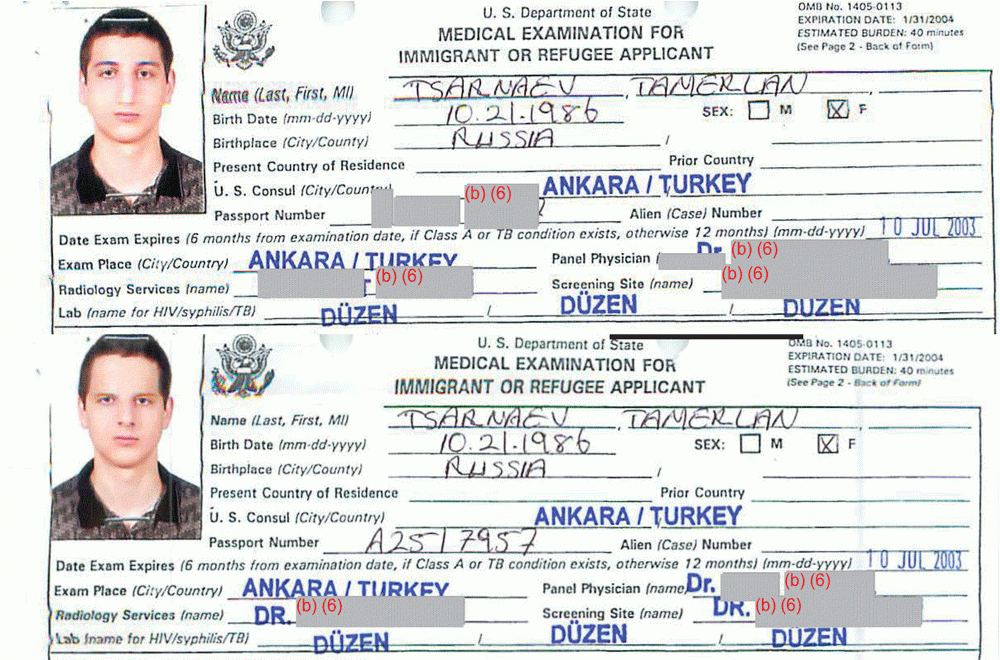
Was Tamerlan Tsarnaev a federal informant?
On April 15, 2013, Tamerlan and his younger brother, Dzhokhar Tsarnaev, attacked the Boston Marathon. It was one of the worst terrorist attacks on U.S. soil since 9/11.
In all, the Tsarnaevs killed four people and injured hundreds more. One of the most intense manhunts in recent history culminated in a violent shootout with police in Watertown, on April 19. Tamerlan was killed in that shootout. Dzhokhar was arrested. Two years later, Dzhokhar was tried on federal terrorism charges. He was found guilty of the bombing and formally sentenced to death.
However, four years after the bombing, after a high-profile federal terrorism trial and multiple government investigations, there are still many unanswered questions, particularly about Tamerlan.
In this special report, we'll investigate some of the most controversial unanswered questions about Tamerlan Tsarnaev:
- Was he a federal informant?
- How does the federal informant program work?
- How do federal agencies recruit Muslims and other immigrants to become informants?
- And did Tamerlan Tsarnaev receive special treatment through this program for his application to become a U.S. citizen?
Part 1: The Theory
In 2014, as Dzhokhar Tsarnaev prepared his defense, his lawyers filed a motion seeking all documents relating to FBI contact with Tamerlan. Why? They believed Tamerlan had been a federal informant.
They wrote: "We base this on information from our client’s family and other sources that the FBI made more than one visit to talk with ... Tamerlan ... and asked him to be an informant, reporting on the Chechen and Muslim community."
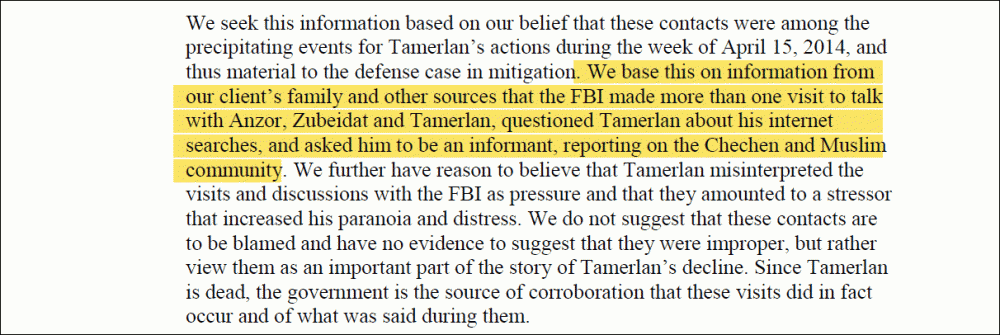
It was the first time that claim had entered the official record.
The government denied then, as it does today, that Tamerlan was ever a federal informant. An FBI spokesperson referred us back to an Oct. 18, 2013 statement the FBI issued along with Boston police and Massachusetts state police. The statement says law enforcement officials did not know the identities of the Tsarnaev brothers before the Watertown shootout, and that they "were never sources for the FBI nor did the FBI attempt to recruit them as sources."
The theory was most recently picked up by investigative reporter Michele McPhee in her new book, "Maximum Harm: The Tsarnaev Brothers, The FBI, and the Road to the Marathon Bombing."
"Tamerlan Tsarnaev was the perfect recruit," says McPhee. "He had tentacles in the drug world. He spoke multiple languages. He could mix in anywhere. He was tall and handsome. He had an American wife. Here was a guy that really was the perfect recruit."
"Tamerlan Tsarnaev was the perfect recruit. He had tentacles in the drug world. He spoke multiple languages. He could mix in anywhere. He was tall and handsome. He had an American wife."
Michele McPhee
McPhee is an Emmy-nominated investigative journalist for ABC News. She’s also a former AM talk radio host and to some, a controversial columnist. But McPhee also has deep sources within local law enforcement, a network she’s developed after years of working at the Boston Herald and as police bureau chief for the New York Daily News.
In "Maximum Harm," McPhee gathers a constellation of law enforcement sources and new evidence that lead her to a startling allegation: She believes federal authorities offered to help Tsarnaev become a U.S. citizen in exchange for being an informant.
"'You help us, we help you,' " McPhee tells Radio Boston.
Tsarnaev desperately wanted citizenship. In 2010 he was featured in a magazine article titled, “Will Box for Passport: An Olympic Drive to Become a United States Citizen.”
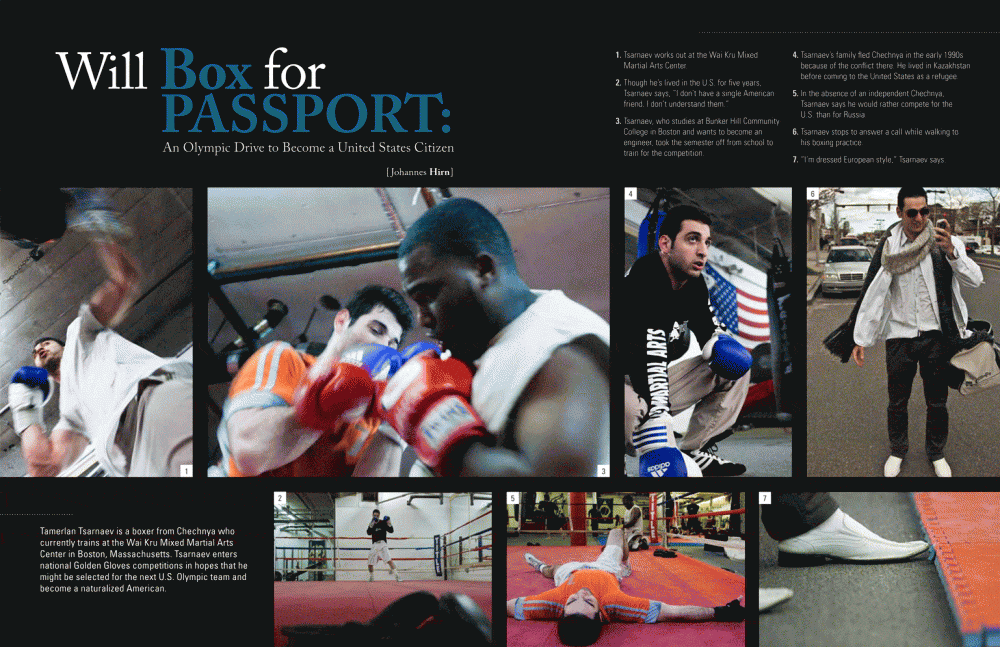
Younger brother Dzhokhar was naturalized in 2012, something that could have intensified Tamerlan's desire for citizenship.
"I mean, his little brother was doing better than he was," says McPhee. And in Dzhokhar's trial, a Tsarnaev relative testified that "it is better to be a dog than the younger son."
"Tamerlan was more than motivated to become a citizen," McPhee says.
The Journey
Our investigation begins with a journey. On Jan. 21, 2012, Tsarnaev flew to Russia, 15 months before the Marathon bombing. U.S. Customs and Border Patrol (CBP) agents allowed Tsarnaev to board his flight without any additional screening, even though a year earlier Russian intelligence services had issued specific warnings about Tsarnaev to both the FBI and CIA.
"Those warnings were: Tamerlan is going to come to Russia and join the jihad," McPhee says. "Well, Tamerlan did indeed go to Russia to join the jihad, was there for six months, came back, and breezed through customs despite the fact he was on multiple terror watch lists on this very day."
Tsarnaev was indeed on U.S. terror watch lists. But what exactly was Tsarnaev doing in the Northern Caucasus region of Dagestan from January to July 2012?
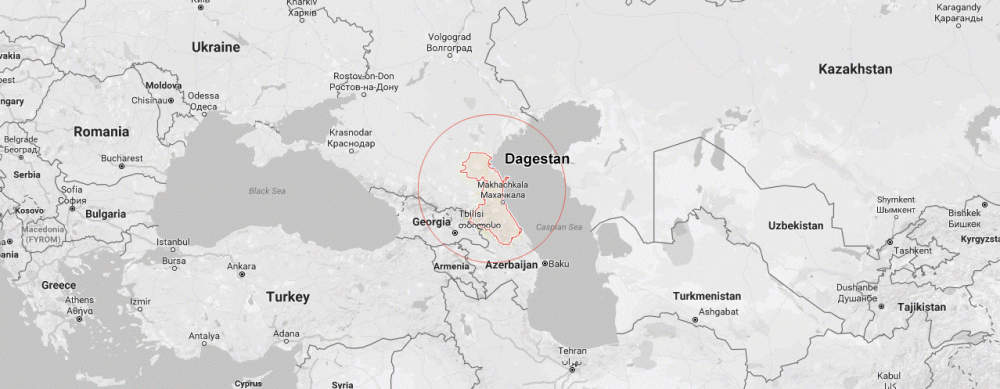
McPhee alleges that Tsarnaev was sent there to aid counter-terrorism operations against Russian Islamic radicals.
There is no definitive evidence to back this claim.
But there are curious coincidences, such as the fact that Tsarnaev was recording conversations he had with family members while in Dagestan. Why would he do that, McPhee wonders. There was also a flurry of counter-terrorism operations in the region during the same six-month period Tsarnaev was there.
"There were seven high level terror targets who were killed by the Russian Interior Ministry, after meeting with Tamerlan Tsarnaev," she says. "Coincidence? Maybe."
When pressed if she is certain Tsarnaev met with radicals, McPhee says, "There are reports of Tamerlan going to this radical mosque in Dagestan. He had met with this man [who] was a recruiter for a roadside bombing that killed a number of first responders and civilians."
Mahmoud Nidal was reportedly a recruiter for Islamist insurgents in Dagestan.
"They were looking for this recruiter," she says. "The recruiter met with Tamerlan at this mosque, and days later he was tracked at his hideout and killed."
Nidal was killed by Russian forces on May 19, 2012, while Tsarnaev was in Dagestan. However, it is unclear if the two men ever actually met.
In 2014, the U.S. House Homeland Security Committee put out a report, "The Road to Boston: Counterterrorism Challenges and Lessons from the Marathon Bombings." It cites a former Russian investigator who says that Nidal would not have been afraid to emerge from hiding to meet with Tsarnaev. But the report also states that American investigators stationed in Moscow uncovered no evidence of a relationship between Nidal and Tsarnaev, nor did they discover proof that Tsarnaev had made any attempts to join Chechen rebel groups.
Russian investigative journalists disagree. They told Massachusetts U.S. Rep. William Keating in 2014 that their sources say Tsarnaev did try to join Chechen fighters, but that he was rejected in part because of his "conspicuously Western style."
Russian forces also killed a second man while Tsarnaev was in Dagestan: William Plotnikov.
"Plotnikov was a Canadian who sparked the warnings that the FSB [Federal Security Service of the Russian Federation], the Russian counterintelligence agencies, had given to both the Boston FBI and to the CIA in 2011," says McPhee.
She adds: "Plotnikov was picked up, intercepted, by the Russian FSB in 2010. They demand his phone and they intercept text messages between William Plotnikov and Tamerlan Tsarnaev."
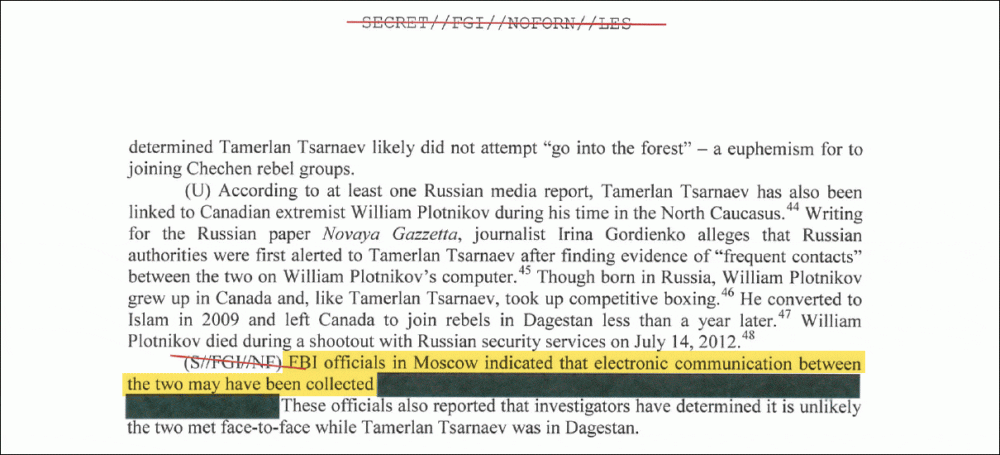
The 2014 House Homeland Security report says it is unlikely that Tsarnaev and Plotnikov met face-to-face while Tsarnaev was in Dagestan. But it also says FBI officials in Moscow did indicate "that electronic communication between the two may have been collected."
Less than a month after the Marathon bombing, Keating sent staff to Russia to investigate alleged ties between Tsarnaev, Plotnikov and Nidal.
"[Plotnikov] was a boxer in Canada. Tamerlan was a boxer. And somehow they had known each other before," Keating said in May 2013.
Plotnikov died in a shootout with Russian security services on July 14, 2012. Three days later Tamerlan Tsarnaev flew back to the United States.
Why then? We don’t know. It could simply be that Tsarnaev had been in Russia for almost six months and being outside of the U.S. for that long may have jeopardized his immigration status.
Keating posited a less benign reason during a Homeland Security Committee hearing in July 2013:
Keating: "We had reports that our office was able to get that he was meeting with a known terrorist, insurgent Mahmoud Nidal. Someone already on their radar screen in Russia, had they known this. Yet there was another gap where that could have been closed. Now he came back to the U.S. after the person he met with, reportedly, was killed, and the other person that was known to him, was killed. So he sort of beat feet and went home, I think."
The Ticket
McPhee sees entirely different forces at work.
"The ticket that allowed him to return to Boston, well it was paid in cash, which is another huge red flag that's not supposed to happen," she says. "Somebody paid 2050 euro for this ticket. Now remember, Tamerlan was unemployed. So who paid for the ticket? How is it in cash? And a receipt which I have as part of the court record. Somebody wanted him right out of the country and they wanted him out fast."
McPhee refers to an airline receipt that investigators found in the bedroom of Tsarnaev’s Cambridge apartment after the Marathon bombing.
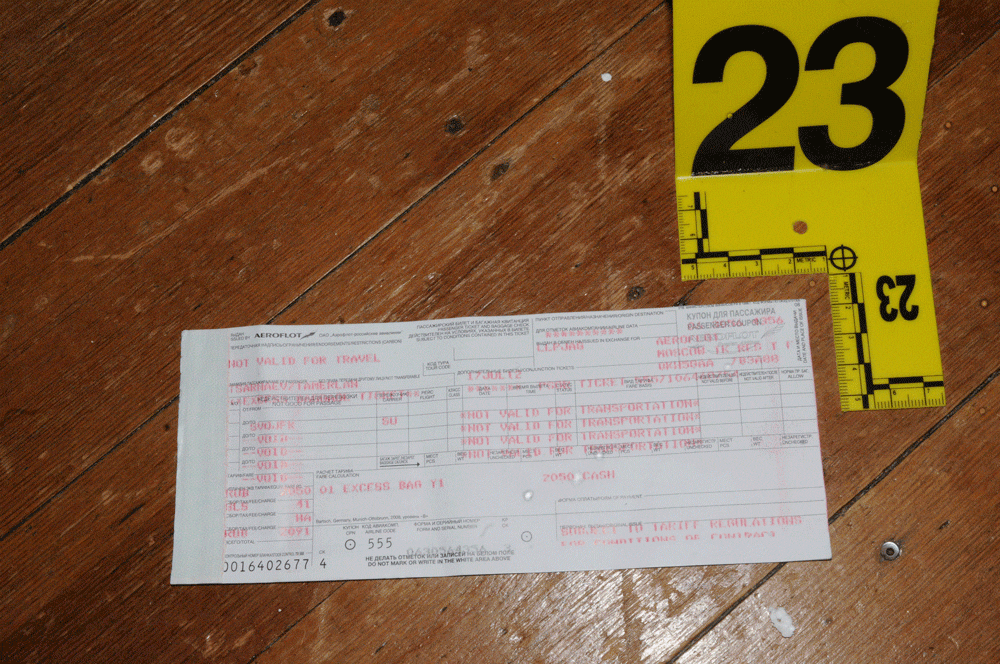
A photograph of the receipt was entered into evidence during Dzhokhar’s trial. According to trial transcripts, attorneys and an FBI witness refer to it as looking like a receipt for "an old fashioned plane ticket" on Aeroflot, the Russian carrier.

We asked travel experts familiar with the Russian airline to examine the photograph of the receipt. They confirm that it is from Aeroflot, and that it was issued to Tamerlan in relation to travel on July 17, 2012.
However, it is not a receipt for a 2050 euro airline ticket, as McPhee says. It is only a receipt for excess baggage, not the entire cost of travel. The receipt is in rubles, not euros. Someone paid 2050 rubles, or about $37, so that Tsarnaev could haul extra luggage onto the plane.
'He Did Not Have A Passport'
Tamerlan flew from Moscow to JFK International Airport in New York, and then to Boston. He was on multiple terror watch lists. McPhee says Tsarnaev should have never been let back into the country.
And yet he was. Easily.
In 2016, following Freedom of Information requests from multiple organizations, the Department of Homeland Security released a redacted version of Tsarnaev’s entire immigration file, also known as an A-file.
In the file: the Customs and Border Protection record that was created when Tamerlan stepped up to the immigration desk at JFK.
"This is really interesting document," McPhee says, "because what it is, is every single time we reenter the county, all of us, you me, you have a DHS Customs Border Patrol Air Entry. So you know, you can do it yourself, or they take the picture at customs. This is a photo of Tamerlan Tsarnaev when he returned on July 17, 2012."
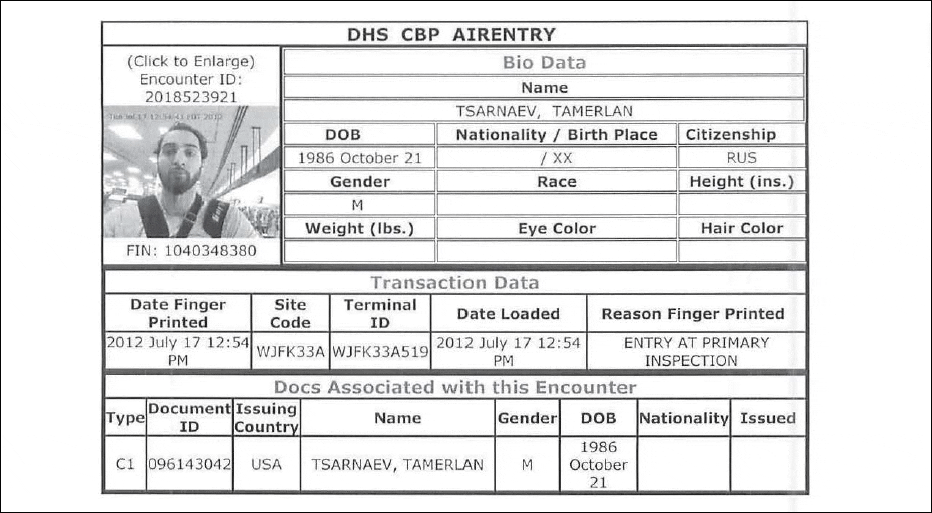
Tsarnaev stares directly into the camera. His face is round and he has a full beard. His hair is slightly disheveled. His name and date of birth are both correct. He was fingerprinted.
Under "Docs Associated with this Encounter," one document is listed as "Issuing Country: USA." McPhee says, "That's his green card ... the Legal Permanent Resident card. He did not have a passport."
McPhee says Tsarnaev had told his family that he had lost his Kyrgyzstan-issued passport. He applied for a new Russian passport while in Dagestan, but left Russia without picking it up.
U.S. Customs and Border Protection rules explicitly state that legal permanent residents are not required to have a passport to reenter the U.S. They simply need to present their green cards.
However, Tsarnaev had been outside the U.S. for 178 continuous days in a region known for terrorist activity. He was just short of the 180-day absence that would have automatically triggered additional screening.
Tsarnaev was also on two terror watch lists. Given these factors in combination, McPhee says Tsarnaev should not have been able to breeze through immigration at JFK Airport.
McPhee: “Think about it. He was still on these terror watch lists. The fact that he had been gone so long should have triggered a secondary alarm, several sources say. In and of itself. The fact they didn't have a passport. The fact that his travel documentations were essentially the green card he was issued because he claimed if he ever went back to Russia he'd be killed. All of it just smacks of either incredible incompetence or a blatant cover-up.”
Chakrabarti: “You’re saying that those coincidences could only have happened if he had some — if he was getting some special attention from the government.”
McPhee: “Someone was pulling the strings. 1,000 percent.”
'Disturbing That Such A Detailed Lookout Could Be Missed'
To McPhee, the constellation of evidence indicates that Tsarnaev had been getting special assistance from the government.
"Someone was pulling the strings. One thousand percent."
Michele McPhee, investigative reporter
There is a more mundane explanation. In 2011, Russian intelligence services had warned both the FBI and the CIA of their concerns about Tsarnaev, and his potential travel to Russia.
In March 2011, the FBI, through the Boston Joint Terrorism Task Force, opened an investigation into Tsarnaev. As part of the investigation, a CBP officer put him in the TECS system, one of the government’s terror watch lists. In October 2011, after receiving another warning from Russia, the CIA placed Tsarnaev in a different terror database, known as TIDE.
Did the system alert Customs and Border Protection agents when Tsarnaev flew to Russia in January 2012? That was what Republican Sen. Chuck Grassley of Iowa wanted to know when then-Secretary of Homeland Security Janet Napolitano testified before the Senate Judiciary Committee in April 2013, just days after the Watertown shootout.
Grassley: "Is it true that his identity document did not match his airline ticket, and if so, why did TSA miss the discrepancy?"Napolitano: "There was a mismatch there ... but, even with the misspelling, under our current system there are redundancies, um uh, and so the system did ping when he was leaving the United States."
Grassley pressed further. Napolitano answered.
Napolitano: "... On the, um, misspelling of Tamerlan's name and what that meant ... I think it would be better if we could discuss those with you in a classified setting."
Two government reports published in 2014 reveal what actually happened.
The TECS database did "ping" when Tsarnaev flew out of JFK on Jan. 21, 2012. His name was put on a list of "passengers of concern" that was sent to Customs and Border Protection in Boston and New York. There were 22 CBP officers assigned to examine passengers on the list that day at JFK. CBP officers determined Tsarnaev was a low priority compared to other passengers on the list. The reports state that "there is no indication that CBP officials at the John F. Kennedy International Airport reviewed the record related Tamerlan Tsarnaev."
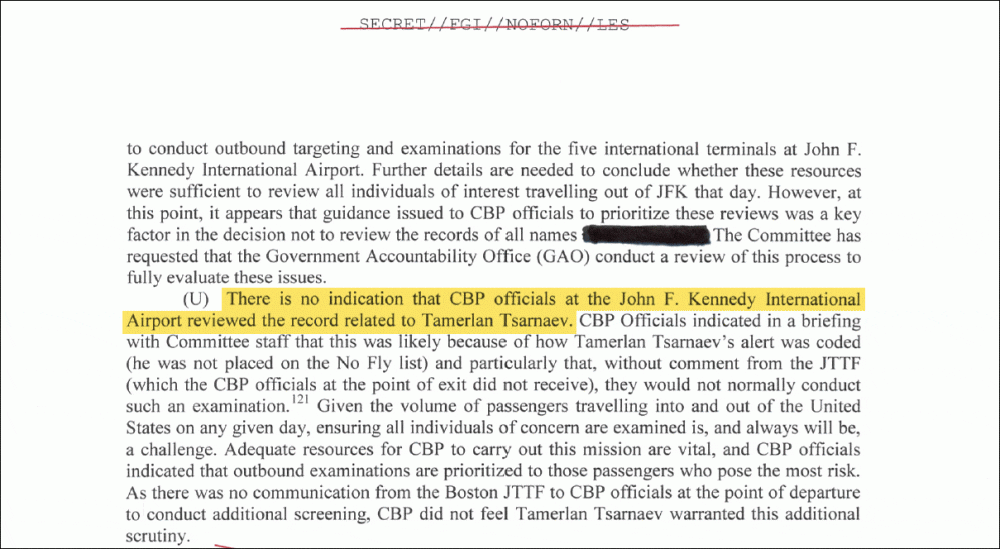
It’s a stunning oversight. The March 2014 House Homeland Security report on the Marathon bombings concluded that Tsarnaev should have been a high-priority target because, "[The] TECS alert was unambiguous in its requests ... that officials encountering Tamerlan Tsarnaev 'Escort [him] to CBP secondary and detain is mandatory whether or not the office believes there is an exact match.' It is disturbing that such a detailed lookout could be missed."
On July 17, 2012, Tsarnaev flew back to JFK. Again, he was not pulled aside at immigration. Sen. Lindsey Graham, a Republican from South Carolina, asked Napolitano why:
Graham: "When he left to go back to Russia in 2012, the system picked up his departure but did not pick up him coming back, is that correct?"
Napolitano: "That’s my understanding and I can give you the detail in a classified setting. But I think the salient fact there, senator, is that the FBI TECS alert on him at that point was more than a year old and had expired."
That turns out not to be true. The alert had not expired. Tsarnaev was still on the watch list. All that had changed was how the TECS database alerted border agents, according to a subsequent government report. The initial alert on Tsarnaev instructed CBP officers to conduct more extensive inspection of Tsarnaev, known as secondary inspection, whenever he attempted to reenter the United States. In March 2012, that alert was set to no longer display on the computer screens of border protection agents working at JFK immigration counters.
Therefore, on July 17, 2012, all Tamerlan Tsarnaev had to do was hand the immigration officer his green card, take a picture, and get fingerprinted, and he was back in the United States. There was no secondary inspection.
Graham observed one more disturbing fact about Tsarnaev’s travel back and forth to Russia:
Graham: "The point I’m trying to make … the FBI ... they had no knowledge of him leaving or coming back."
How is this possible? The TECS database did in fact send alerts to the Joint Terrorism Task Force in Boston, specifically the CBP officer who first put Tsarnaev on the watch list. The 2014 House Homeland Security report states that "it is not clear that this information was shared with others on the Boston JTTF."
The April 2014 report published by the inspectors general of the intelligence community, CIA, Department of Homeland Security and Justice Department goes even further. It says the CBP officer followed normal procedures in communicating with Tsarnaev’s FBI case officer. He passed along the information about the terror watch list alerts via "email, orally, or by passing a 'sticky note.' "
"This is where we are in the war on terror," says McPhee, "that border patrol is putting a sticky note on an FBI counter-terrorism officer’s desk ... give me a break."
"This is where we are in the war on terror, that border patrol is putting a sticky note on an FBI counter-terrorism officer’s desk ... give me a break."
Michele McPhee, investigative reporter
The 2014 House Homeland Security report offers an even more withering assessment: "This lack of communication represents a failure to proactively share information that could potentially save lives."
Part 2: Immigration Vulnerabilities And Informants
Despite these clear bureaucratic reasons that explain why Tsarnaev so easily passed in and out of the United States, McPhee still believes there’s more to the story. She believes that the federal government offered Tsarnaev a chance to become a U.S. citizen in exchange for being an informant, and that’s why he walked through immigration without a second look.
Boston has unique experience with the FBI informant program. There is precedent for the government protecting criminal activity of its own informants.
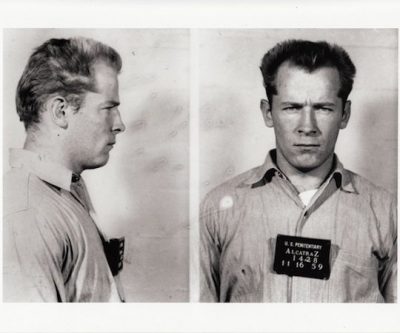
James "Whitey" Bulger was a murderous criminal mobster. In 1975, he began cooperating with the government and became a "Top Echelon Informant."
"The FBI gave the exact same denials about Whitey Bulger for decades," says McPhee, "and we all know now that there is evidence. And I sat through the Whitey Bulger trial every single day; the summer of Whitey. I was there. I mean, it was staggering."
Bulger murdered people while he was an informant. The FBI protected him. In 1995, Bulger was finally indicted. But before he could be arrested, Bulger ran; his FBI handler had tipped him off. Bulger successfully evaded capture for 16 years before he was finally arrested in June 2011.
After the attacks of Sept. 11, 2001, law enforcement shifted its focus from the mob to counter-terrorism. McPhee says the new focus also made its way into the federal informant program.
"After 9/11, there was a huge push to recruit Muslims to inform on other Muslims in mosques," says McPhee. "They call it 'mosque crawling' — raking."
The program was pioneered by the New York City Police Department. McPhee watched the program up close in her work as police bureau chief for the New York Daily News.
"I worked out of One Police Plaza for decades," she says, a reference to the NYPD headquarters. "I know a lot about the terrorist interdiction unit. And what they did, which was genius, was they recruited Muslims who had taken the civil service just to come up become police officers. And they went to [CIA headquarters in] Langley and they were trained just like CIA agents. And the program was wildly successful."
One measure of that success: Nearly half of more than 500 recent federal terrorism convictions came from informant-based cases.
'The Perfect Terrorist'
The use of informants in counter-terrorism cases is also highly controversial. Federal informants have been directly involved in several high-profile attempted and successful terrorist attacks.
The most spectacular of these cases involves David Headley. In 2010, he pleaded guilty to masterminding the 2008 Mumbai terrorist attack that killed more than 160 people.
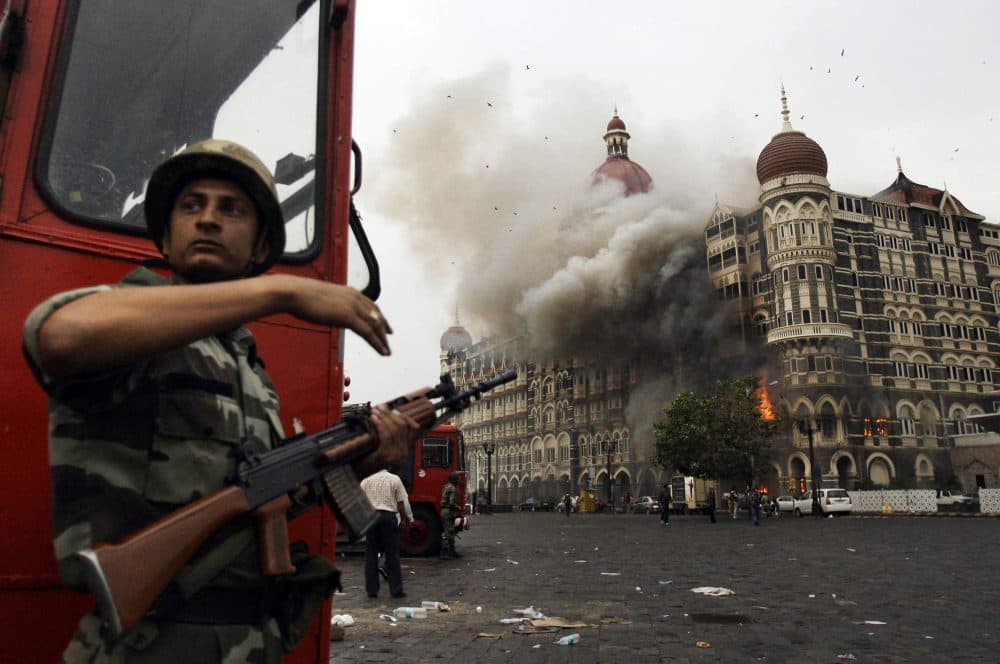
Headley is Pakistani-American. In the mid-1990s, he was arrested for drug trafficking. He became an informant for the Drug Enforcement Agency (DEA), in exchange for a reduced sentence. After 9/11, the DEA turned its attention to counter-terrorism and told Headley to gather intelligence on extremists in New York and Pakistan. But Headley did not abandon his own extremist views. He told friends he celebrated al-Qaida's attack on New York, which lead the FBI to open the first of several investigations into Headley.
The PBS series "Frontline" covered the case in its documentary, "A Perfect Terrorist."
The DEA sent Headley to Pakistan as an American intelligence operative, but off the books, according to U.S. officials who spoke with "Frontline." While there, Headley began training with a Pakistani terrorist group, a fact he did not hide from his family. His wife grew so concerned, she went to the U.S. Embassy in Lahore to report her husband. The FBI made inquiries into Headley’s activities at least six times before the Mumbai attack, but they interviewed Headley only once. They never took action against him.
Why? The government would not respond to "Frontline’s" inquiries, and vast portions of Headley’s trial remain under seal.
Headley's case is extreme, but there are thousands of federal informants whose activities are difficult for Congress to monitor. In 2016, an audit of the DEA's confidential informant program found the agency itself "did not appropriately track all confidential source activity."
Massachusetts U.S. Rep. Stephen Lynch is calling for greater oversight of informant programs. In April 2017, he filed the Confidential Informant Accountability Act, citing crimes committed by other federal informants, including one who had been arrested in 43 states.
Lynch: "Good luck to him on the remaining seven states. But if a guy’s been arrested in 43 states, he should not be eligible as a confidential informant, especially one highly paid. Zero credibility. That’s disgraceful ...
The bill would also require law enforcement agencies to report, just report, all serious crimes committed by their confidential informants. Including an accounting of the total number of each type and category of crime."
'The FBI Began To View The Entire Muslim Community As Suspect'
There are currently 18,000 informants working for the DEA. At the FBI, there could be more than 15,000.
"That number 15,000 gets thrown around, but I would actually find that number to be fairly small," says Michael German, a national security expert with the Brennan Center for Justice at New York University. German is also a former FBI special agent and worked undercover on domestic terrorism cases for 16 years from 1988 to 2004.

"Every FBI agent is required to participate in the informant program, and to have actively producing informants," he says. "There are roughly 13,000 FBI agents. Do the math. The fact that you would have two per agent wouldn’t be very surprising to me."
German says no one else should be surprised either.
German: "Informants are the bread and butter of law enforcement — always have been, always will be. The problem after 9/11 is the FBI began to view the entire Muslim community as suspect. So the idea was FBI agents, we need to have better information about what's going on. But because the entire Muslim community was viewed as suspect, basically any Muslim that the government had some leverage over could be coerced into becoming an informant."
However, German says it's unlikely that Tamerlan Tsarnaev was a federal informant. He takes a law enforcement veteran’s measured approach, pointing to the fact that the CIA and FBI put Tsarnaev on terrorist watch lists in 2011, not something they would usually do for one of their own "assets."
But he also adds, "The idea that the FBI would approach an individual who is in the immigration process to encourage them to become an FBI informant with the — not the promise of — but at least dangling the idea that that might be beneficial to their interests, certainly wouldn't be out of the realm of possibilities and would probably be likely."
In 2013, German authored a report for the American Civil Liberties Union titled, "Unleashed and Unaccountable: The FBI’s Unchecked Abuse of Authority." The report claims that "the FBI has aggressively pressured members of the American Muslim community to become informants for the FBI, particularly on immigrants who rely on the government to process their ... citizenship applications in a fair and timely manner."
The ACLU points to an FBI training presentation — a PowerPoint the group obtained under a Freedom of Information Act request. The 2012 document contains sections that teach FBI agents to recruit Muslim informants by exploiting "immigration vulnerabilities," and that agents should have a "firm grasp on immigration law."
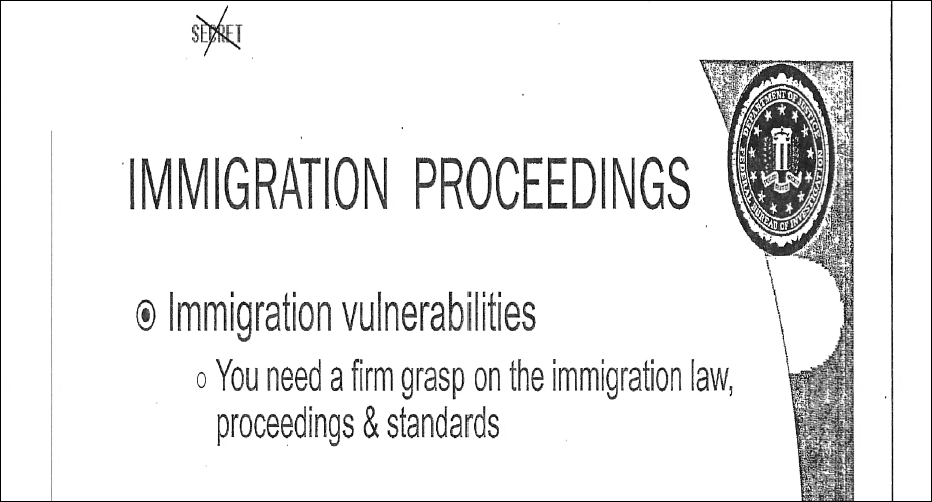
"Immigrants who who need assistance by the government to process their immigration papers — that's an opportunity to try to put pressure on somebody to convince them that it's in their best interest and might assist in acquiring their immigration benefits if they participate in becoming an informant," says German.
The FBI is not allowed to make explicit offers of citizenship to potential informants.
In 2006, then-U.S. Attorney General Alberto Gonzales issued guidelines on confidential human sources that said, "No promises or commitments can be made, except by the United States Department of Homeland Security, regarding the alien status of any person or the right of any person to enter or remain in the United States."
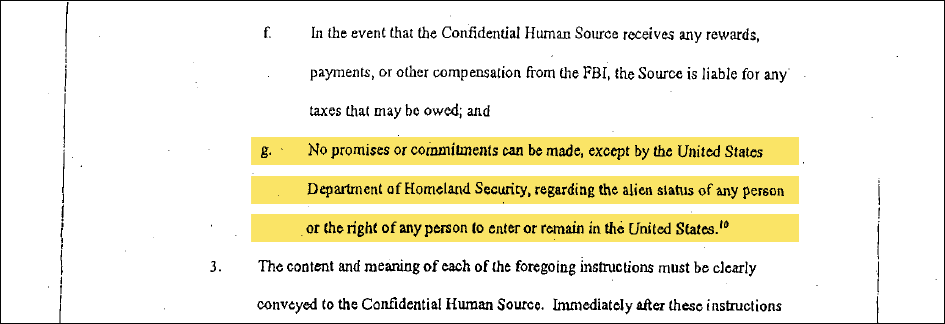
However, German says, "The implication is often that they can, right? The FBI is trying to give that person the impression that they can help them. And whether that's true or not, the FBI is allowed to lie to somebody."
This is where things get even murkier. While the FBI is not allowed to use explicit offers of citizenship to entice potential informants, German says law enforcement agencies in fact do have significant sway on an immigrant’s citizenship application.
"It's often a very fuzzy line," he says. "And there is a program called CARRP where the FBI can put a delay on the provision of immigration benefits."
CARRP, or the Controlled Application Review and Resolution Process, was first implemented covertly by United States Citizenship and Immigration Services (USCIS) in 2008. Its goal is to "ensure that immigration benefits are not granted to individuals and organizations that pose a threat to national security."
CARRP casts a wide net. Immigration officials will not say exactly how many people fall under the program, but last year Buzzfeed reported that between 2008 to 2012, the case files of over 19,000 people from 18 Muslim-majority countries were rerouted through CARRP.
More importantly, CARRP gives law enforcement agencies significant say in the immigration proceedings for any person of national security concern. Through a process known as "deconfliction," CARRP allows the FBI to request that USCIS "grant, deny or place in abeyance" an immigrant’s citizenship application.
A spokesperson for USCIS says, "Deconfliction is a step to ensure that USCIS properly considers the impact of a national security concern on eligibility and that any planned USCIS action does not impede any investigations or law enforcement activities relating to the concern."*
We have incorporated many responses from USCIS received after publication of our original story into this post and you can click here to see USCIS' full reply to our inquiries.*
The ACLU concluded that, "Under CARRP, USCIS officers are instructed to follow FBI direction. ... As a result, CARRP has effectively turned the immigration benefits adjudication process over to the FBI."
When asked to respond to the ACLU’s conclusion, the USCIS spokesperson says, "USCIS is not a law enforcement agency, and it must work with law enforcement and intelligence agencies that possess information relevant to USCIS adjudications. The FBI is an important partner in the security and background check process conducted on all individuals requesting an immigration benefit, and USCIS considers relevant information obtained through or provided by the FBI."*
The USCIS spokesperson also says, "Although USCIS works with law enforcement agencies in possession of information impacting its adjudications, USCIS maintains its authority to adjudicate immigration benefit requests."*
The ACLU also claims that the FBI uses its authority under CARRP to recruit immigrant informants.
"Clearly under the current program, the FBI could delay or halt the immigration proceedings," says German. "It's certainly possible that the FBI would look at somebody who is processing to obtain citizenship and attempt to use that leverage to gain cooperation."
"It's certainly possible that the FBI would look at somebody who is processing to obtain citizenship and attempt to use that leverage to gain cooperation."
Mike German, former FBI special agent
We sent a detailed list of questions to the FBI, USCIS and the Department of Homeland Security seeking more information. The FBI would not respond and instead referred all CARRP-related questions to Homeland Security. DHS did not answer our inquiries. After publication, we followed up with USCIS, and a spokesperson sent responses.*
Part 3: The A-File
In August 2012, following his six month trip to Russia, Tamerlan Tsarnaev submitted his application for U.S. citizenship.
DHS released a heavily redacted version of Tsarnaev’s entire immigration file, also known as an A-File, in February 2016, following years of Freedom of Information requests from multiple media organizations.
Documents and routing slips in the file indicate that Tsarnaev's naturalization application was processed through CARRP.
USCIS would not respond to questions pertaining to CARRP processing of Tsarnaev's naturalization application, saying it does not comment on the internal handling procedures of specific cases.*
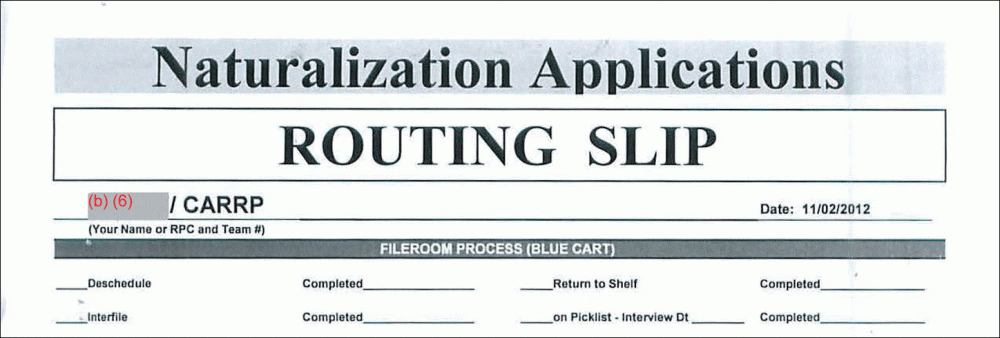
"There are specific officers that are deemed CARRP officers and they get the file before a person is even interviewed by immigration," says Susan Church, former chair of the New England chapter of the American Immigration Lawyers Association.
Immigration attorneys say those specially trained CARRP officers should have noted multiple red flags in Tsarnaev’s naturalization application.
For example, his six-month trip to Russia in 2012. Tsarnaev reported that trip on his naturalization form, but back in 2003, Tsarnaev was first allowed into the United States as the son of an asylum seeker.
"No asylum seeker should be going back to their own country without raising concern and red flags on the part of the U.S. government," says Ellen Kief, an immigration attorney in Boston.
"No asylum seeker should be going back to their own country without raising concern and red flags on the part of the U.S. government."
Ellen Kief, Boston immigration attorney
Kief says USCIS looks harshly upon such trips. "USCIS's position is that, if somebody travels abroad back to their home country, it suggests that they may no longer be in need of protection in the U.S.," Kief says.
USCIS considers such travel as evidence of immigration fraud. People can get deported even if they hold a green card. Yet in Tsarnaev’s case, his six-month trip to Dagestan appeared to raise no flags at all.
A spokesperson for USCIS will not confirm which country Tsarnaev's family sought asylum from in 2003. The spokesperson says the information was redacted from Tsarnaev’s A-File due to "confidentiality and privacy protections and/or due to pending litigation on the case of the brother, Dzhokhar Tsarnaev."*
The spokesperson does not directly address Tsarnaev's travel to Russia in 2012 but says "temporary or brief travel usually does not affect permanent resident status."*
In fact, immigration experts tell us that Tsarnaev’s application was processed with unusual speed. He appeared for his final naturalization interview and civics tests in January 2013, just five months after he began the application process.
"Absolutely, I would say that's definitely fast for what we believe is the norm," Church says, regarding applicants caught up in CARRP process who usually wait much longer. "I would say in the last five years, they are taking at a bare minimum a year. I haven't seen any gone through in less than a year, and sometimes I've seen them take two years."
A spokesperson for USCIS says, "All immigration benefit requests are handled on a case-by-case basis, and individual case processing times vary widely depending on resolution and adjudication of all eligibility factors. Each case, CARRP or otherwise, is decided on its own merits according to existing laws, regulations, and USCIS policies, and with a commitment to ensuring national security, public safety, and the integrity of the immigration system."*
In Tsarnaev’s case, immigration officials did make direct inquires to counter-terrorism agents. They contacted the FBI and the Boston Joint Terrorism Task Force multiple times in October and November 2012, asking whether Tsarnaev was a national security concern.
McPhee: "The USCIS officer repeatedly went back to the FBI and said, 'This guy is on a terror watch list. Why would I give him citizenship?' The FBI would say, 'We found nothing wrong with him. He is wonderful. Give him citizenship.' This went back and forth for months."
Following each request, law enforcement officials sent back replies to USCIS stating, "There is no national security concern related to [Tamerlan Tsarnaev]." Immigration officials even once met directly with the FBI counter-terrorism agent assigned to Tsarnaev. They discussed intelligence on Tsarnaev that Russian security services had provided the FBI in 2011. The FBI agent told the immigration officer that he had no "derogatory information” about Tsarnaev and that he had “no opposition to [his] naturalization."
![Excerpt from "Unclassified Summary of Information Handling and Sharing Prior to the [bombings]," prepared by federal agency inspectors general and released April 2014](https://media.wbur.org/wp/2017/06/IGcitizen.gif)
"How many times have you heard the ACLU talk about how Muslims are not getting citizenship even if they are here — they don't have a criminal record, they're employed, they've been sponsored by a major company, they can't get citizenship," she says. "But you have an unemployed Muslim who's on multiple terror watch lists, who is connected to drug dealers, and this guy is the perfect candidate that the FBI is pushing him through? It makes no sense."
It’s another one of those unanswered questions whose answer could be sensational, or mundane. A mundane explanation: The Boston FBI had no objection to Tsarnaev becoming a citizen because it had closed its assessment of him on June 24, 2011. They had found nothing at the time to connect Tsarnaev to any "nexus of terrorism." However, the FBI’s legal attache in Moscow kept its case file on him open.
More Puzzling Inconsistencies
In April 2014, inspectors general of the U.S. Intelligence Community, the CIA, the Justice Department and the Department of Homeland Security released an unclassified summary of their report on federal information handling prior to the Boston Marathon bombing.
The report concludes that Tamerlan was given his final naturalization interview on Jan. 23, 2013. It says no decision about his citizenship was made at that time because USCIS was waiting for court records related to a prior assault and battery charge. In 2009, Tsarnaev had been arrested in Cambridge for slapping his girlfriend. The charges were dropped.
The inspectors general report contains this remarkable passage: "The USCIS officer told the [Homeland Security inspector general] that had the court records been processed before [January] ... he would have had no grounds to deny the application."
![Excerpt from "Unclassified Summary of Information Handling and Sharing Prior to the [bombings]"](https://media.wbur.org/wp/2017/06/IGcourt.gif)
However, when Tsarnaev’s redacted immigration file was released to the public in 2016, the Cambridge court records were in his file and they were there when an immigration officer gave Tsarnaev his final naturalization interview in January 2013. The DHS confirmed to the Boston Globe that the court records were in the file.
Why would the inspectors general of the U.S. intelligence community, who presumably had access to Tsarnaev’s complete, unredacted immigration file, conclude that his criminal court records were not in his application prior to the Marathon bombings, when in fact, they were?
Who Is This Other Person?
There are two other documents in Tamerlan’s immigration file that beg explanation.
One page contains what looks like the screenshot of a computer window. Written across the top of the window: "Oath Ceremony Schedule for TAMERLAN TSARNAEV." The window also contains oath ceremony location information, and a time and date: Oct. 16, 2012, 8 a.m.
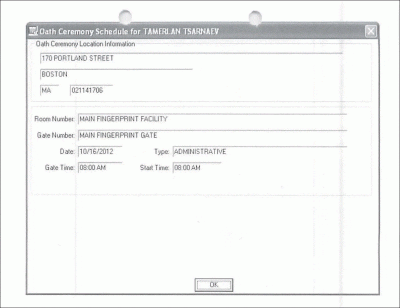
Tsarnaev did not complete naturalization interview until Jan. 23, 2013, so what is this document that seems to indicate a final oath ceremony was scheduled two months before his interview?
A spokesperson for USCIS says this "part of the system pertains to the most recent or scheduled appointment related to the application." This includes appointments for biometrics collection, an interview or an oath ceremony. According to the spokesperson, "[Tsarnaev’s] N-400 was never approved, and someone may not be scheduled for an oath ceremony before the application has been adjudicated."*
Finally, there are two copies of a medical examination form dated July 10, 2003. The exam was required prior to Tsarnaev’s first arrival in America on asylum in 2003. The forms are virtually identical -- names, signatures, even the shape of check marks and stamps. They resemble exact color photocopies of each other, except for one thing.
The forms contain photographs of two different people:
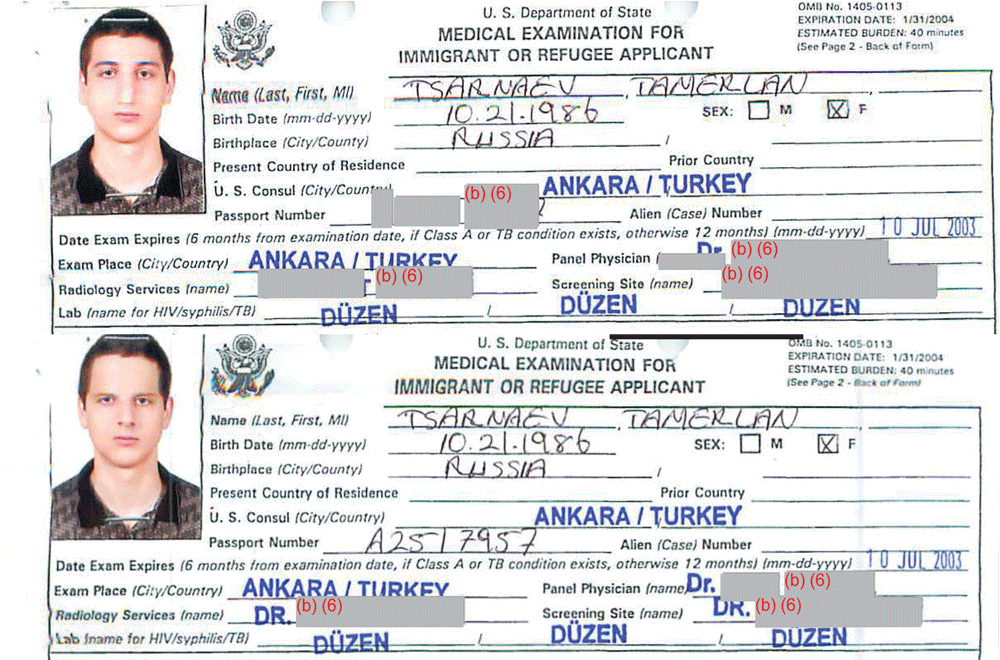
On one form, the picture of a young Tamerlan Tsarnaev. On the other, a photograph of a different person. His eyes are different, his eyebrows are lighter, his nose is a different shape. And yet, he’s wearing the exact same patterned shirt and dark collar as Tsarnaev is. The passport number near the picture of the unidentified person is not redacted. That number matches the one on Tsarnaev’s Kyrgyzstan passport.
We wondered if there was a straightforward explanation. Initially, USCIS did not provide us with an explanation on the record. Instead, the agency sent us the same statement it made in 2016: "While USCIS found no errors in the processing of Tsarnaev’s ... application, we are always seeking to strengthen our very intensive screening processes."*
After publication of this piece, we followed up with USCIS and spokesperson says, "The errors in the photo were the result of scanning issues. The photos are being rescanned to be added to the documents available on the USCIS electronic reading room."*

On Jan. 23, 2013, an immigration officer interviewed Tsarnaev at the JFK federal building in Boston. He passed the English and U.S. history tests. The officer recommended the government grant Tsarnaev citizenship. All that remained was one final approval from a higher level supervisor, due to his 2009 assault and battery charge.
Investigative reporter McPhee says there’s no way Tsarnaev could have known that. All he was told by the immigration officer that day was that a decision could not be made at that time.
"He stormed out and 12 days later, he’s at Phantom Fireworks buying the biggest and loudest pyrotechnics in the store," she says, referring to the store in Seabrook, New Hampshire.
Less than three months later, Tamerlan and his brother bombed the Marathon.
Part 4: 'Maybe The Answers Will Emerge Over Time'
McPhee spent three years investigating these questions. She too recognizes that the truth about Tsarnaev remains elusive.
Meghna Chakrabarti: "But you see what I’m getting at? There's a lot of interesting pieces and all this documentation that that you've come up with -- I mean, heck of a lot of smoke --but some people are going to say there's no fire here because no one has been, you know, we don't have the piece of paper that puts Tamerlan Tsarnaev on the list of FBI informants."
McPhee: "People say it's not a smoking gun. But what I've created is a map and the road to the end of this map leads to the fact that somebody was helping Tamerlan Tsarnaev. Somebody with a lot of power and that's somebody I believe was in the federal government. Now can you definitively say he was an FBI informant? Well, I mean the government is masterful at semantics. So perhaps, he was listed under a different agency. Perhaps he was an informant on loan. I mean the Department of Homeland Security has multiple units that would have used Tamerlan successfully including the Drug Enforcement Unit. So there are a lot of unanswered questions and yet you say it, there's smoke everywhere. Well look, if a building is billowing with black smoke it is very likely that there is a fire somewhere within the walls."
Chakrabarti: "I mean Michele, what you're saying — people are going to hear — and I mean — because another way of interpreting what you're saying is that the FBI made him. Or that if he became radicalized by doing work as an informant on behalf of the United States government and then because he wasn't allowed to become a citizen at the end, that that radicalization tipped him over into bombing the Boston Marathon."
McPhee: "It wouldn't be the first time. I mean Tamerlan, believe me, I believe he's a sociopath. You can't put a backpack behind a row of children like he did, like his brother did, without being sick in the head to begin with. I don't think it's malfeasance. I don't believe anyone in any federal capacity knew that they were going to blow up the marathon. I think it’s just bureaucratic incompetence."
On this point, former FBI special agent German agrees.
"Hindsight is 20-20," he says. "When the FBI swears in a new agent, they gave him a gun and a badge, but they don't give him a crystal ball."
Question, after question, after unanswered question — many asked by other reporters over the years — and mostly met with official denial or silence.
Ultimately, the story about all that we do not know about Tamerlan Tsarnaev is really a story about what we, the public, will accept as truth.
There are many ways to process the theory that the government offered Tamerlan help with citizenship in exchange for being a federal informant.
You can believe all of it.
Or, you can dismiss it all as wild conspiracy theory.
Or, you can acknowledge something in between. Why aren’t federal authorities more eager to answer these questions? Especially when the government has asked one of the biggest questions itself.
Who Built The Bombs?
In 2014, one year before Dzhokhar’s death penalty trial began, prosecutors filed a pretrial motion that stated the bombs were sophisticated devices that "... would have been difficult for the Tsarnaevs to fabricate successfully without training or assistance from others ... searches of the Tsarnaevs' residences, three vehicles, and other locations associated with them yielded virtually no traces of black powder, again strongly suggesting that others had built, or at least helped the Tsarnaevs build, the bombs, and thus might have built more."

The motion was signed by the lead prosecutor in the case, then-Assistant U.S. Attorney William Weinreb, now acting U.S. attorney for Massachusetts. WBUR asked Weinreb in February 2017 if the government still believes other bomb-makers may be out there.
Weinreb: "I've prosecuted a lot of cases. The Boston Marathon bombing case was one of the most thoroughly investigated cases that I have ever come across. There were many, many, many investigators. And they looked under every rock and left nothing unexamined. Despite all of that investigation, I think it is fair to say that there are still a number of questions unanswered about that case. Maybe the answers will emerge over time."
The government itself can pursue the answer to that question. We do not know if there is an ongoing investigation into who made the Marathon bombs.
Part 5: Should We Want To Know?
How much secrecy should Boston accept in the name of security?
We put the question to McPhee. "That's why [the book, "Maximum Harm"] was so important to me," she says. "I do not blame anyone for what happened at the Boston Marathon. It's a horrible set of circumstances but I think that we are owed the truth at the very least."
And McPhee adds, "Now, again, there are so many hardworking agents all over the nation who are quite literally giving up their entire lives to protect us from terrorism. I recognize that all day. But at the same time when things go wrong there has to be some sunshine and there has to be some questions that has to make sure that that doesn't happen again."
German, the former FBI special agent, agrees.
"I see a huge problem with the government not being more forthcoming," he says. "And I think the FBI is its own worst enemy in this situation where we know that the absence of evidence or gaps in information are playgrounds for conspiracy theorists."
German does not believe Tamerlan was a federal informant, but he says something even more important is at stake.
German: "Ultimately, the FBI and the intelligence community survive because the public trust them. And when when you have these gaps in the story it makes it harder for the public to trust them and easier to trust theories that suggest that it's the government itself that is the problem. And I think that's very dangerous to our national security.
Whether it's the Fort Hood attacks, the Mumbai attacks that I mentioned, the Boston Marathon bombing. What happens after an attack is we tend to find the government knew a lot more and didn't properly manage that information and address all the leads."
German is now at the NYU Brennan Center for Justice. He says a full accounting is still possible through the justice system, because the truth about the government’s relationship with terrorists comes out in the course of their criminal trials.
But in Boston's case, Dzhokhar Tsarnaev was put on trial. Not Tamerlan.
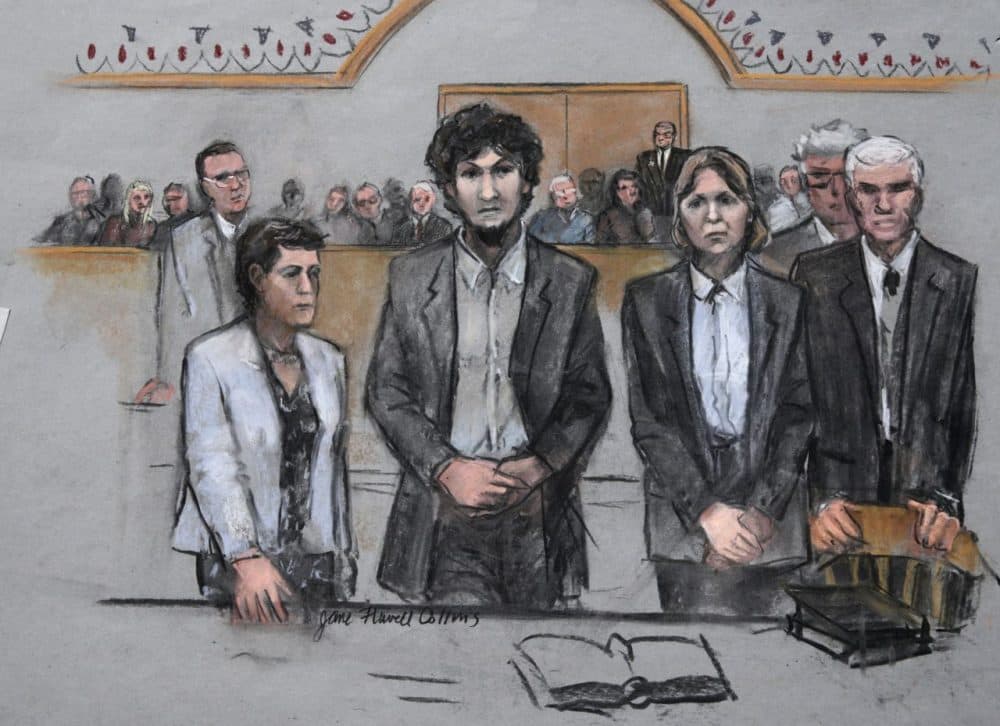
To be clear, Tamerlan and Dzhokhar Tsarnaev are guilty of attacking a beloved Boston event. They are guilty of killing and maiming innocent people. Dzhokhar’s own lawyers said he did it. No one doubts that.
Dzhokhar was convicted on federal terrorism charges on April 8, 2015. A judge formally sentenced him to death on June 24, 2015. Immediately before the sentencing, Dzhokhar addressed his victims for the first time saying, "I am sorry for the lives that I’ve taken, for the suffering that I’ve caused you, for the damage that I’ve done. Irreparable damage."
There is still a tight shroud of secrecy wrapped around much of this case. Major portions of the trial remain under seal.
Tsarnaev’s defense team is currently preparing his appeal. In January 2017, they filed a motion requesting access to 13 documents that prosecutors never disclosed to the defense during Tsarnaev’s original trial. The government will not even disclose the subject area of the documents to the defense.
Prosecutors opposed the defense motion, and bolstered their argument to keep the trial documents secret by submitting even more secret information to the court.
German, the former FBI special agent, concludes with a somber caution.
"Instead of doing a full accounting for what happened, there is a knee jerk reaction to shut the lid on it," he says. "But that causes more problems than it solves and just ensures that we're going to have future catastrophes like this that that could have been prevented."
*This post was updated to reflect responses sent from USCIS after publication. You can see USCIS' full reply here.
Contact Radio Boston:
-- Encrypted email: radioboston@protonmail.com
-- Twitter: @RadioBoston
"Unanswered Questions About Tamerlan Tsarnaev" was produced by Jamie Bologna. Tim Skoog engineered and mixed this hour. Alison Bruzek is our web producer. Hitesh Hathi is our executive producer.
This article was originally published on June 15, 2017.
This segment aired on June 14, 2017.

